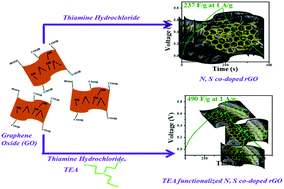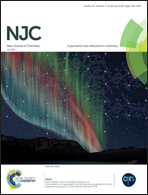Surface modification of co-doped reduced graphene oxide through alkanolamine functionalization for enhanced electrochemical performance†
Abstract
This manuscript presents the facile synthesis of alkanolamine functionalized N,S co-doped reduced graphene oxide (NSrGO) using thiamine hydrochloride as a reducing and co-doping agent for N and S, and triethanolamine (TEA) as a functionalizing agent. The functionalization of TEA molecules on N,S co-doped rGO (TEA–NSrGO) was confirmed by FTIR and XPS analyses. Chemical functionalization of TEA on the surface of NSrGO minimizes restacking of the co-doped sheets and results in an enhanced surface area, as was evidenced by FESEM, TEM, and BET measurements. Moreover, the formation of oxygen-containing groups on NSrGO via covalent functionalization of TEA molecules effectively tunes the surface chemistry of NSrGO, making the electrode material accessible to electrolyte ions. Interestingly, the synergistic effect of TEA functionalization and co-doping in rGO results in impressive electrochemical performance, with a high specific capacitance value of 363 F g−1 at 20 A g−1, outstanding cycling stability (91% retention after 10 000 cycles at 20 A g−1), high coulombic efficiency (99.5–100%), and high energy/power density (31.86 W h kg−1/7646 W kg−1). These electrochemical features suggest the potential of this electrode material for energy storage applications.



 Please wait while we load your content...
Please wait while we load your content...